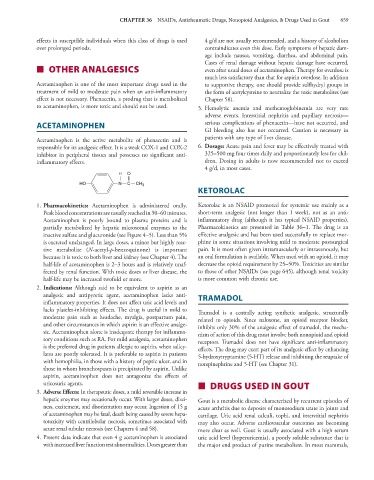Page 673 - Basic _ Clinical Pharmacology ( PDFDrive )
P. 673
CHAPTER 36 NSAIDs, Antirheumatic Drugs, Nonopioid Analgesics, & Drugs Used in Gout 659
effects in susceptible individuals when this class of drugs is used 4 g/d are not usually recommended, and a history of alcoholism
over prolonged periods. contraindicates even this dose. Early symptoms of hepatic dam-
age include nausea, vomiting, diarrhea, and abdominal pain.
Cases of renal damage without hepatic damage have occurred,
■ OTHER ANALGESICS even after usual doses of acetaminophen. Therapy for overdose is
much less satisfactory than that for aspirin overdose. In addition
Acetaminophen is one of the most important drugs used in the to supportive therapy, one should provide sulfhydryl groups in
treatment of mild to moderate pain when an anti-inflammatory the form of acetylcysteine to neutralize the toxic metabolites (see
effect is not necessary. Phenacetin, a prodrug that is metabolized Chapter 58).
to acetaminophen, is more toxic and should not be used. 5. Hemolytic anemia and methemoglobinemia are very rare
adverse events. Interstitial nephritis and papillary necrosis—
ACETAMINOPHEN serious complications of phenacetin—have not occurred, and
GI bleeding also has not occurred. Caution is necessary in
Acetaminophen is the active metabolite of phenacetin and is patients with any type of liver disease.
responsible for its analgesic effect. It is a weak COX-1 and COX-2 6. Dosage: Acute pain and fever may be effectively treated with
inhibitor in peripheral tissues and possesses no significant anti- 325–500 mg four times daily and proportionately less for chil-
inflammatory effects. dren. Dosing in adults is now recommended not to exceed
4 g/d, in most cases.
H O
HO N C CH 3
KETOROLAC
1. Pharmacokinetics: Acetaminophen is administered orally. Ketorolac is an NSAID promoted for systemic use mainly as a
Peak blood concentrations are usually reached in 30–60 minutes. short-term analgesic (not longer than 1 week), not as an anti-
Acetaminophen is poorly bound to plasma proteins and is inflammatory drug (although it has typical NSAID properties).
partially metabolized by hepatic microsomal enzymes to the Pharmacokinetics are presented in Table 36–1. The drug is an
inactive sulfate and glucuronide (see Figure 4–5). Less than 5% effective analgesic and has been used successfully to replace mor-
is excreted unchanged. In large doses, a minor but highly reac- phine in some situations involving mild to moderate postsurgical
tive metabolite (N-acetyl-p-benzoquinone) is important pain. It is most often given intramuscularly or intravenously, but
because it is toxic to both liver and kidney (see Chapter 4). The an oral formulation is available. When used with an opioid, it may
half-life of acetaminophen is 2–3 hours and is relatively unaf- decrease the opioid requirement by 25–50%. Toxicities are similar
fected by renal function. With toxic doses or liver disease, the to those of other NSAIDs (see page 645), although renal toxicity
half-life may be increased twofold or more. is more common with chronic use.
2. Indications: Although said to be equivalent to aspirin as an
analgesic and antipyretic agent, acetaminophen lacks anti- TRAMADOL
inflammatory properties. It does not affect uric acid levels and
lacks platelet-inhibiting effects. The drug is useful in mild to Tramadol is a centrally acting synthetic analgesic, structurally
moderate pain such as headache, myalgia, postpartum pain, related to opioids. Since naloxone, an opioid receptor blocker,
and other circumstances in which aspirin is an effective analge- inhibits only 30% of the analgesic effect of tramadol, the mecha-
sic. Acetaminophen alone is inadequate therapy for inflamma- nism of action of this drug must involve both nonopioid and opioid
tory conditions such as RA. For mild analgesia, acetaminophen receptors. Tramadol does not have significant anti-inflammatory
is the preferred drug in patients allergic to aspirin, when salicy- effects. The drug may exert part of its analgesic effect by enhancing
lates are poorly tolerated. It is preferable to aspirin in patients 5-hydroxytryptamine (5-HT) release and inhibiting the reuptake of
with hemophilia, in those with a history of peptic ulcer, and in norepinephrine and 5-HT (see Chapter 31).
those in whom bronchospasm is precipitated by aspirin. Unlike
aspirin, acetaminophen does not antagonize the effects of
uricosuric agents. ■ DRUGS USED IN GOUT
3. Adverse Effects: In therapeutic doses, a mild reversible increase in
hepatic enzymes may occasionally occur. With larger doses, dizzi- Gout is a metabolic disease characterized by recurrent episodes of
ness, excitement, and disorientation may occur. Ingestion of 15 g acute arthritis due to deposits of monosodium urate in joints and
of acetaminophen may be fatal, death being caused by severe hepa- cartilage. Uric acid renal calculi, tophi, and interstitial nephritis
totoxicity with centrilobular necrosis, sometimes associated with may also occur. Adverse cardiovascular outcomes are becoming
acute renal tubular necrosis (see Chapters 4 and 58). more clear as well. Gout is usually associated with a high serum
4. Present data indicate that even 4 g acetaminophen is associated uric acid level (hyperuricemia), a poorly soluble substance that is
with increased liver function test abnormalities. Doses greater than the major end product of purine metabolism. In most mammals,

